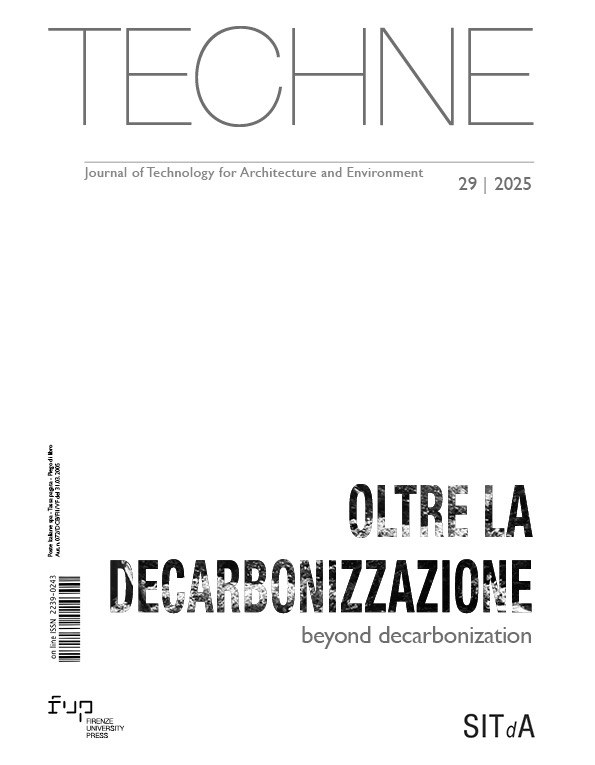Dossier
Published 2025-07-31
How to Cite
Tato, B., Vallejo, J. L., Rizzetto, M., & Liebes, L. (2025). Polinature, a prototype for a plug-in bioclimatic urban oasis. TECHNE - Journal of Technology for Architecture and Environment, (29), 45–51. https://doi.org/10.36253/techne-17672
Copyright (c) 2025 Belinda Tato, Jose Luis Vallejo, Marco Rizzetto, Lily Liebes

This work is licensed under a Creative Commons Attribution 4.0 International License.
Downloads
Download data is not yet available.
References
- Amorim-Maia, A.T. et al. (2023), “Seeking refuge? The potential of urban climate shelters to address intersecting vulnerabilities”, Landscape and Urban Planning, Vol. 238. Available at: https://doi.org/10.1016/j.landurbplan.2023.104836. DOI: https://doi.org/10.1016/j.landurbplan.2023.104836
- Błazejczyk, K. et al. (2013), “An introduction to the Universal thermal climate index (UTCI)”, Geographia Polonica, Vol. 86, n. 1, pp. 5-10. Available at: https://doi.org/10.7163/GPol.2013.1. DOI: https://doi.org/10.7163/GPol.2013.1
- Chen, P. (2024), “Inequality in heat: The role of spatial patterns of urban green infrastructure”, Urban Climate, Vol. 53. Available at: https://doi.org/10.1016/j.uclim.2024.101820. DOI: https://doi.org/10.1016/j.uclim.2024.101820
- Choi, H.M. et al. (2024), “Temperature, Crime, and Violence: A Systematic Review and Meta-Analysis”, Environmental Health Perspectives, Vol. 132, n. 10. Available at: https://doi.org/10.1289/EHP14300. DOI: https://doi.org/10.1289/EHP14300
- Hall, D.M. et al. (2017), “The city as a refuge for insect pollinators”, Conservation Biology, Vol. 31, n. 1, pp. 24-29. Available at: https://doi.org/10.1111/cobi.12840. DOI: https://doi.org/10.1111/cobi.12840
- IPBES (2019), Summary for policymakers of the global assessment report on biodiversity and ecosystem services. Zenodo. Available at: https://doi.org/10.5281/zenodo.3553579.
- The Prevention Institute and UCLA Fielding School of Public Health (2020), Park Equity, Life Expectancy, and Power Building – Center for Occupational & Environmental Health. Available at: https://coeh.ph.ucla.edu/park-equity-life-expectancy-and-power-building/ (Accessed on 06/11/2024).
- Vasiliev, D. and Greenwood, S. (2021), “The role of climate change in pollinator decline across the Northern Hemisphere is underestimated”, Science of The Total Environment, Vol. 775. Available at: https://doi.org/10.1016/j.scitotenv.2021.145788. DOI: https://doi.org/10.1016/j.scitotenv.2021.145788
- Weston, P. (2024), “Patches of wildflowers in cities can be just as good for insects as natural meadows–study”, The Guardian, 20 November. Available at: https://www.theguardian.com/environment/2024/nov/20/patches-of-wildflowers-in-cities-can-be-just-as-good-for-insects-as-natural-meadows-study-aoe (Accessed on 27/11/2024).
- Wolch, J.R., Byrne, J. and Newell, J.P. (2014), “Urban green space, public health, and environmental justice: The challenge of making cities ‘just green enough’”, Landscape and Urban Planning, Vol. 125. Available at: https://doi.org/10.1016/j.landurbplan.2014.01.017. DOI: https://doi.org/10.1016/j.landurbplan.2014.01.017
- Zajdel, B. et al. (2024), “Sown wildflower meadows: Can they replace natural meadows in urban spaces for bees, butterflies and hoverflies?”, Ecological Entomology. Available at: https://doi.org/10.1111/een.13396. DOI: https://doi.org/10.1111/een.13396





